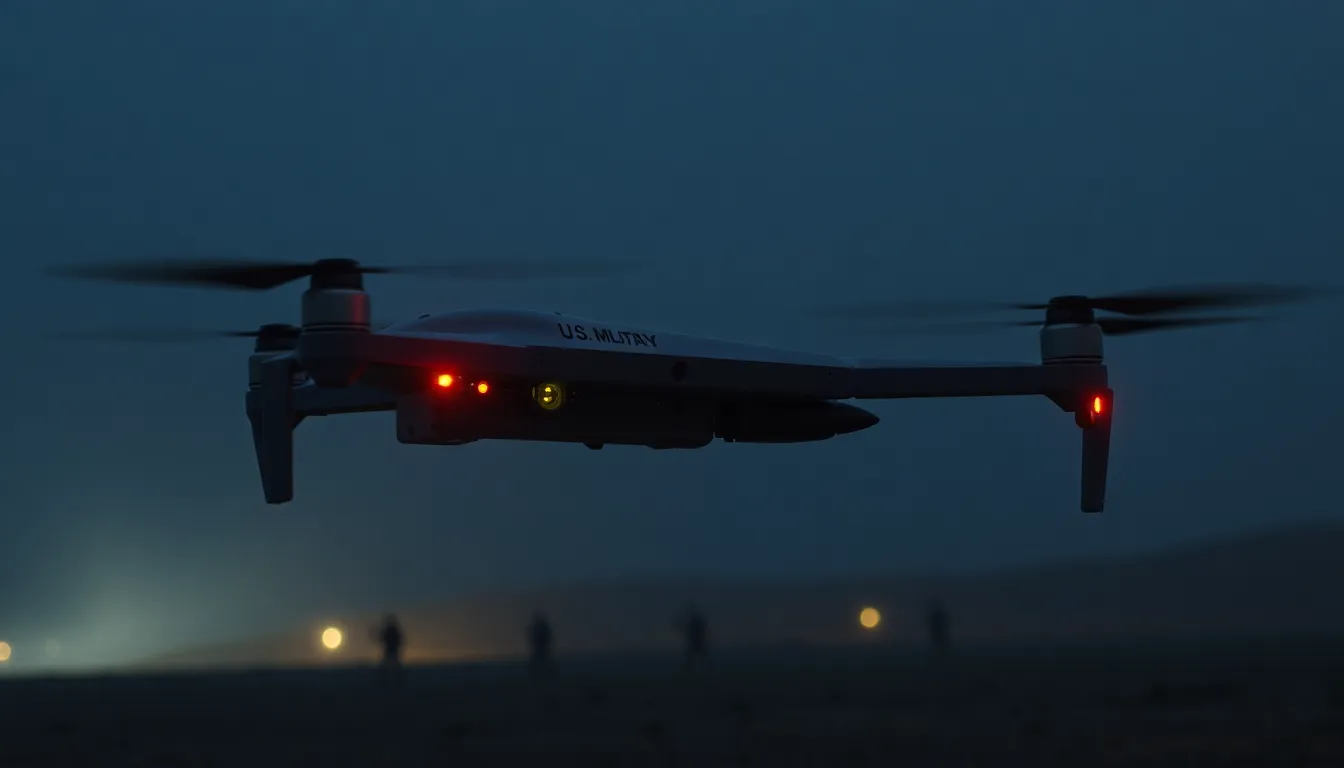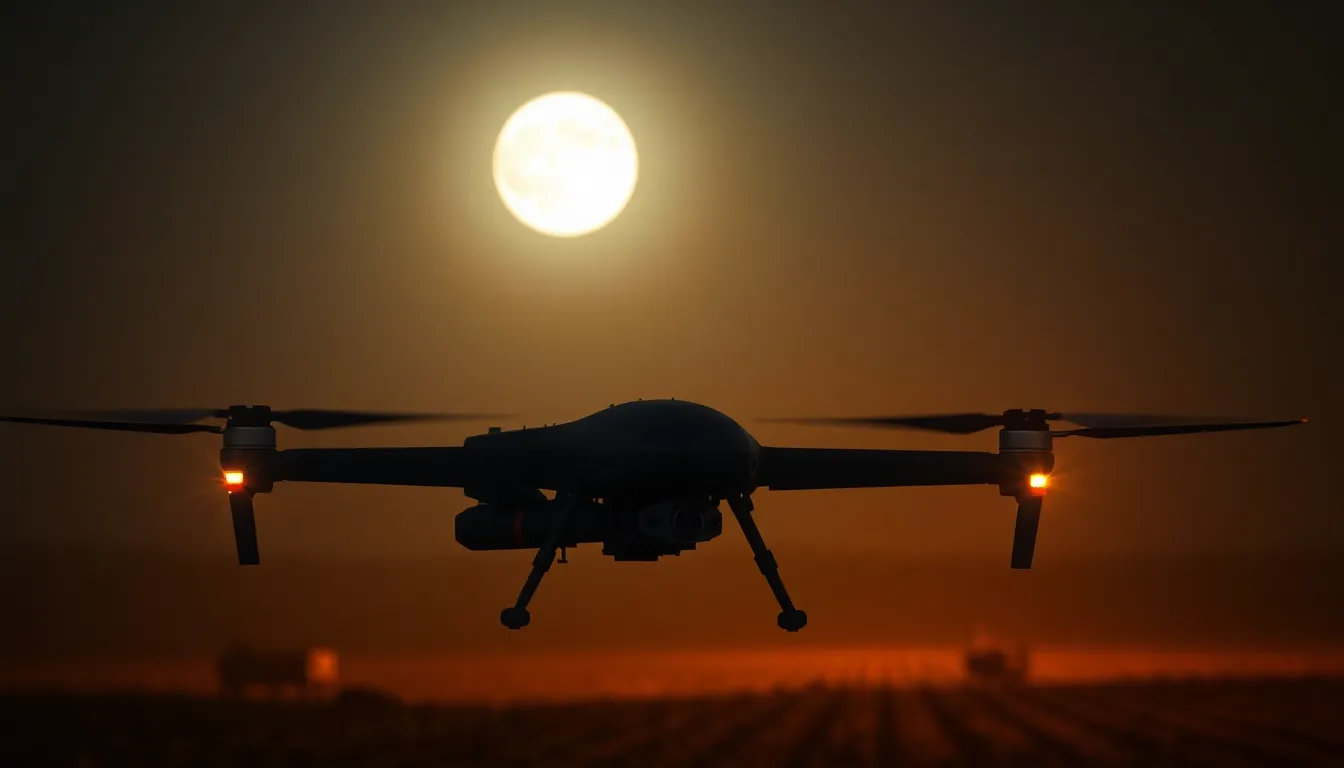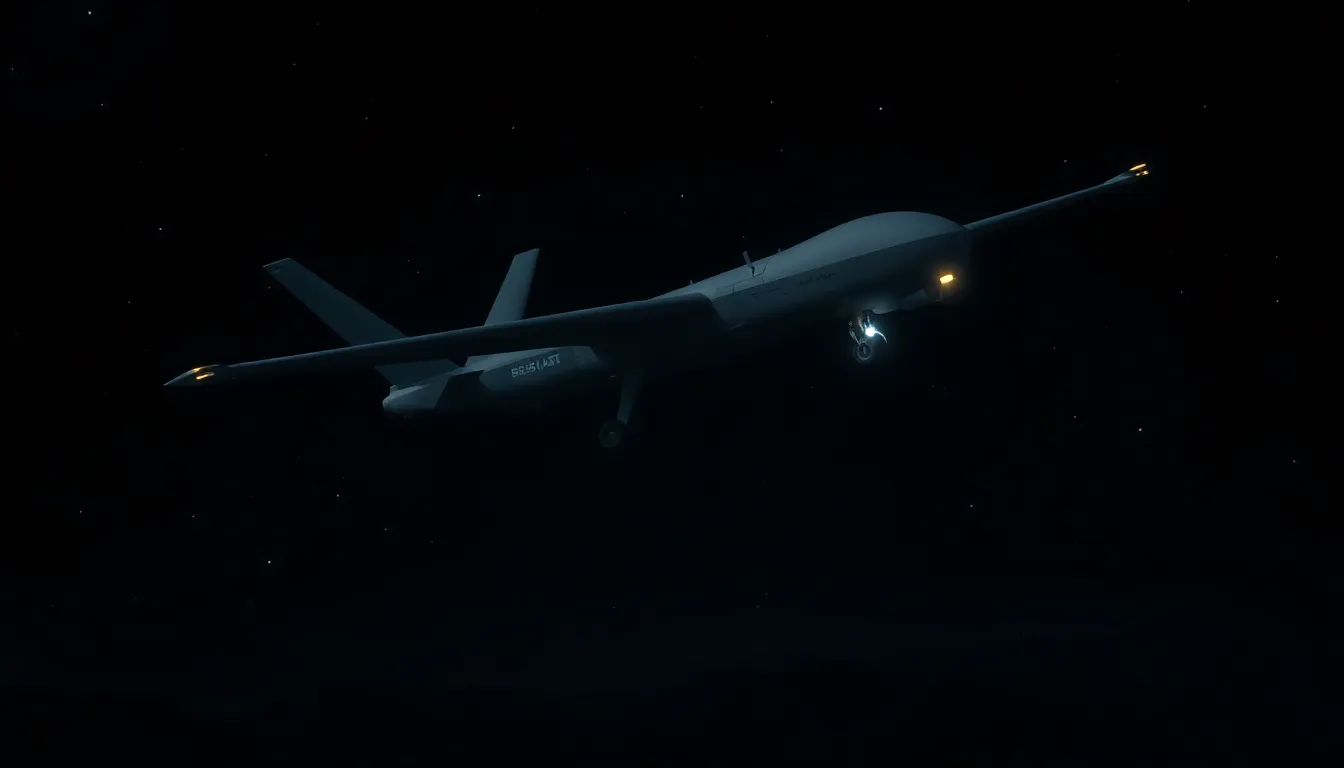As the sun dips below the horizon and darkness blankets the battlefield, a new breed of soldier takes to the skies—military drones. These high-tech marvels don’t just fly; they glide through the night with the grace of a seasoned ninja, equipped with cutting-edge technology that even Batman would envy. Who needs a cape when you’ve got thermal imaging and night vision?
While traditional forces might be stubbing their toes in the dark, these unmanned aerial vehicles (UAVs) shine brighter than a disco ball at a 70s party. They provide real-time surveillance and precision strikes, all while keeping human pilots safely tucked away in cozy command centers. In a world where every second counts, military drones at night are transforming the landscape of modern warfare, proving that sometimes, the best way to fight is to stay out of sight.
Table of Contents
ToggleOverview Of Military Drones At Night
Military drones play a crucial role in nighttime operations. These advanced unmanned aerial vehicles integrate technologies like thermal imaging and night vision. Surveillance becomes more effective when using these systems, allowing for detailed reconnaissance in darkness.
Heightened precision during strikes is another advantage of nighttime drone operations. Operators can identify targets accurately, minimizing collateral damage. Command centers remotely control these drones, ensuring pilot safety in hostile environments.
Stealth is paramount in modern combat, especially at night. Drones equipped with quiet propulsion systems evade enemy detection effectively. Their ability to operate silently enhances mission success, allowing for covert observation and engagement.
Data processing capabilities of military drones provide real-time information to commanders. This instant access to critical data improves decision-making during complex scenarios. Surveillance footage assists in assessing enemy positions and movements.
Many military organizations continue to invest in advancements for nighttime operations. Innovations in sensor technology enhance the effectiveness of drone missions. Future developments may focus on increasing the endurance and range of these UAVs.
Overall, military drones at night signify a transformation in warfare. Their ability to conduct operations in darkness ensures tactical advantages. With ongoing technological improvements, the impact of these drones on combat effectiveness will grow.
Capabilities Of Military Drones


Military drones possess advanced capabilities that enhance their effectiveness in nighttime operations. These unmanned aerial vehicles utilize cutting-edge technologies, including thermal imaging and night vision, to excel in various mission profiles.
Surveillance And Reconnaissance
Surveillance is a primary function of military drones, especially at night. They gather critical intelligence through high-resolution cameras and sensors capable of detecting activity in complete darkness. These drones provide operators with real-time video feeds, allowing for effective monitoring of enemy movements. Enhanced sensors ensure precise data collection, contributing to accurate assessments of battlefield conditions. Additionally, drones can stay airborne for extended periods, enabling continuous reconnaissance missions. Their ability to operate silently minimizes the risk of detection, making them invaluable for covert operations.
Target Acquisition
Target acquisition benefits significantly from the capabilities of military drones. Equipped with advanced targeting systems, drones can identify and lock onto specific targets with remarkable accuracy. They utilize infrared and multispectral imaging to distinguish between different objects, even in low-light environments. This technology allows operators to assess potential threats and engage them effectively. Precision targeting minimizes the risk of collateral damage, ensuring strikes focus on intended objectives. Furthermore, drones can relay crucial information back to command centers swiftly, enhancing the decision-making process during high-stakes situations.
Technologies Enhancing Night Operations
Innovations in drone technology greatly improve military operations at night. These advancements lead to superior surveillance, reconnaissance, and strike capabilities.
Infrared Sensors
Infrared sensors detect heat emitted from objects, providing a clear image in complete darkness. These sensors excel at identifying warm targets, such as vehicles or personnel. Military drones equipped with infrared technology enhance situational awareness, allowing operators to monitor enemy activity effectively. Since these sensors operate independently of visible light, they prove invaluable during nighttime missions. Their readouts assist in making tactical decisions based on real-time data, increasing operational success rates.
Night Vision Cameras
Night vision cameras amplify existing light to create images in low-light conditions. These cameras enhance the visibility of targets during nighttime operations, significantly improving reconnaissance efforts. With high-resolution outputs, operators can analyze footage in detail. Night vision technology enables drones to provide actionable intelligence even in challenging lighting situations. This capability allows military personnel to maintain an edge over adversaries, ensuring that critical decisions are made based on accurate information at all hours.
Strategic Advantages Of Night Operations
Night operations significantly enhance the strategic capabilities of military drones. Stealth becomes a primary factor, as drones can conduct missions under the cover of darkness without attracting enemy attention. Operating discreetly, these unmanned aerial vehicles (UAVs) bypass conventional detection methods, allowing them to gather intelligence and execute strikes with greater effectiveness.
In terms of technology, the integration of thermal imaging and advanced sensors facilitates superior reconnaissance when visibility is limited. Thermal sensors identify heat signatures, providing clear images of targets and surroundings, even in total darkness. Real-time data from these sensors enables military forces to adapt strategies rapidly, ensuring a tactical edge.
Another advantage lies in extended operational capabilities. Drones remain airborne for long durations, which allows continuous surveillance without the need for frequent returns to base. This persistence enhances situational awareness, providing commanders with up-to-date information throughout operations.
Precision targeting forms a crucial element of night operations. Drones equipped with infrared and multispectral imaging systems can accurately identify and engage targets, significantly reducing collateral damage. Enhanced targeting algorithms optimize strike capabilities, ensuring that military objectives are met with reliability and efficiency.
Enhanced nighttime operational capabilities reflect ongoing investments in drone technology. Military organizations committed to improving night operations benefit from innovations in UAV design and sensor technologies. Such advancements contribute to increasingly effective engagement strategies, elevating the role of drones in modern warfare dynamics.
Overall, the strategic advantages of military drones during night operations emphasize their importance in contemporary combat scenarios.
Challenges Faced By Military Drones At Night
Operating military drones at night presents numerous challenges. Limited visibility impacts navigation and targeting accuracy. Pilots rely heavily on advanced technologies like thermal imaging and night vision, which can sometimes produce variable results depending on environmental conditions.
Weather conditions contribute significantly to operational difficulties. Heavy rain, fog, or strong winds can obstruct sensor performance, complicating surveillance missions. These factors often reduce the effectiveness of high-resolution cameras and infrared systems, potentially hampering real-time intelligence gathering.
Drone operators encounter technical limitations as well. Some sensors may struggle to differentiate between multiple heat signatures, leading to misidentification of targets. Compounding this issue, electronic warfare tactics can disrupt communications between the drone and its control center, jeopardizing mission efficacy.
Endurance becomes a logistical challenge for long-duration missions. Battery life remains a constraint, limiting the time drones can stay airborne. As drone systems evolve, ensuring adequate power supply for night operations remains a priority.
Enemy countermeasures often present additional obstacles. Adversaries may employ tactics to exploit drones’ vulnerabilities, such as jamming signals or deploying decoys. Drones may find their stealth compromised as advanced detection technology continues to evolve, necessitating ongoing adaptation by military forces.
Adverse terrain adds to the operational complexity. Urban environments can impede flight paths due to buildings and other structures, making navigation and precise targeting challenging. All these factors underscore the need for continuous innovation in drone technology to enhance performance during nighttime operations.
Military drones are transforming nighttime operations in modern warfare. Their advanced technologies enable effective surveillance and precise strikes under the cover of darkness. As military organizations continue to invest in innovations, these unmanned aerial vehicles are set to enhance their operational capabilities further.
The strategic advantages of stealth and efficiency allow for real-time intelligence gathering and targeted engagements, minimizing risks for human operators. While challenges exist, the ongoing development of sensor technology and improved navigational systems will likely address these obstacles.
The future of military drones at night promises to redefine combat dynamics, ensuring they remain a vital asset in achieving tactical superiority.



